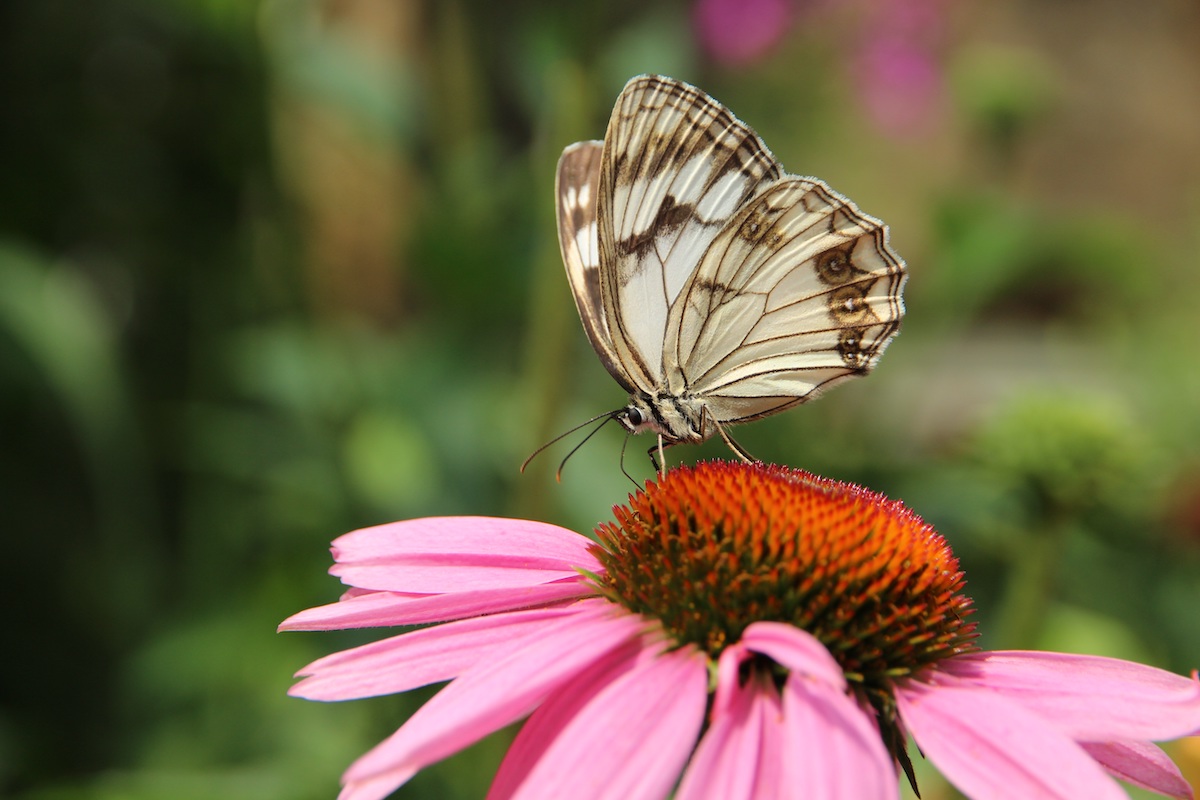
You love how marigolds, cornflowers, and begonias brighten up your landscape, but replanting these annuals every season takes time and energy. Try your hand at perennial flowers instead.
A perennial landscape will show off bright colors, brilliant textures, and intoxicating fragrances, and you needn’t replant these bloomers every year. Perennials often survive those frigid winters, regrowing in the spring or summertime from their old roots or the seeds they dropped last growing season.
We’re sharing with you 21 flowering perennials that will help turn your landscape into a showstopper year after year without the required annual backache. Check out the plant hardiness zones, bloom times, color varieties, and shade tolerances to determine the best perennials for your garden. And don’t miss out on our section where we ask the experts!
21 Perennials for Your Garden
1. Coneflower

Gardeners love these showy flowers for their full heads and vibrant petals. These beautiful flowers grow between 2 to 4 feet tall and are striking when grown in the masses. Coneflowers look stunning when grown across a wild meadow, and will look just as dreamy and whimsical in your own front yard.
Bloom time: Midsummer to fall.
Shade or sun: Full sun.
Color varieties: Pink, yellow, orange, red, purple, white, gold, and green.
Common names: Echinacea.
Hardiness zones: 3-9
Best time to plant: Spring or early summer.
2. Daylily
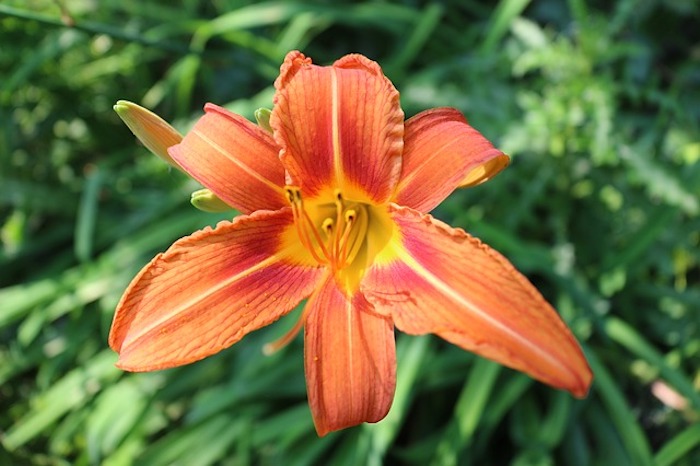
These stunning flowers establish quickly and survive well through the winter. Gardeners love these flowers for their disease and pest resistance, low-maintenance, soil tolerance, and dependable blooms year after year.
Bloom time: Early spring to fall.
Shade or sun: Prefers full sun. Will tolerate light shade.
Color varieties: Yellow, orange, red, white, and pink.
Common names: Daylily.
Hardiness zones: 4-9
Best time to plant: Late spring, summer, or early fall.
3. Aster

Asters will add magnificent pops of color to your landscape, bringing a sense of cheer and joy as the warmer days soon come to an end. These blooms will also attract helpful pollinators, like bees and butterflies, to your yard.
Bloom time: Late summer to early fall.
Shade or sun: Full sun to partial sun.
Color varieties: Purple, red, white, blue, and pink.
Common names: Aster.
Hardiness zones: 3-8
Best time to plant: Spring
4. Black-eyed-Susan

These golden-yellow flowers can sprout up to 3 feet tall, brightening the landscape while needing little maintenance. They look glorious grown in the masses, turning any forgotten field into a wonderland.
Bloom time: Summer to fall.
Shade or sun: Prefer full sun, but can tolerate partial sun.
Color varieties: Orange, red, and yellow.
Common names: Rudbeckia.
Hardiness zones: 3-9
Best time to plant: Spring or early fall.
5. Coreopsis

These daisy-like blooms are drought-tolerant, low-maintenance, and long-lasting, making them an excellent choice for a first time gardener (or an experienced one). Keep in mind these sunny flowers can grow as annuals or perennials, so make sure you buy the right variety.
Bloom time: Early summer to early fall.
Shade or sun: Full sun.
Color varieties: Yellow, orange, red, pink, coral, and white.
Common names: Tickseed or pot of gold.
Hardiness zones: 4-9
Best time to plant: Early spring to fall.
6. Phlox

The phlox’s striking blooms grow as frilly clusters of small, delicately shaped flowers. You’ll love the varying colors (especially those light blue flowers), long-lasting blooms, and sweet fragrance.
Bloom time: Spring to fall.
Shade or sun: Sun and shade preferences depend on plant variety.
Color varieties: Violet, pink, red, white, or pale blue
Common names: Garden phlox and summer phlox.
Hardiness zones: 4-8
Best time to plant: Spring.
7. Hostas

Turn the dreary patch underneath your tree into an exciting shade garden with these shade-loving hostas. Their variegated foliage will look beautiful in the moonlight or a moon garden, and they’ll surprise you in the summer with their elegant, sprouting blooms.
Bloom time: Summer to fall.
Shade or sun: Shade.
Color varieties: Pink, purple, and white.
Common names: Plantain lily.
Hardiness zones: 3-9
Best time to plant: Early spring to late summer.
8. Hydrangea
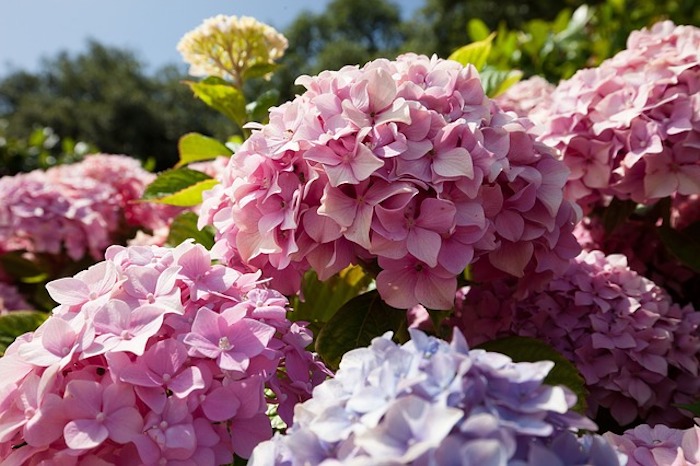
Hydrangea is the beauty queen of perennials. The shrub’s beautiful round flower clusters will add a timeless charm to your landscape. With proper care, these low-maintenance plants will produce abundant blooms for years to come.
Bloom time: Mid-spring to early fall.
Shade or sun: Partial sun. Prefer full morning sun with afternoon shade.
Color varieties: Pink, purple, red, white, green, and blue.
Common names: Hortensia.
Hardiness zones: 3-9
Best time to plant: Spring or fall.
9. Peonies

If you’re building a shabby chic she shed or interior living space, then you’ll want these charming blooms in a vase right where everyone can see them. Their soft colors bring an air of elegance, and fragrance differs widely depending on the variety. Some of these flowers have no scent at all, while others have a striking rose scent.
Bloom time: late spring to early summer.
Shade or sun: Full sun.
Color varieties: Purple, white, pink, yellow, and red.
Common names: Peony.
Hardiness zones: 3-8
Best time to plant: Fall.
10. Sedum

Even succulents, with their peculiar textures and patterns, fleshy leaves, and high drought-tolerance, produce attractive flowers. Sedums grow a tall clump of small, tightly packed blossoms, turning your dry, low-growing succulent garden into a blanket of color and fluffy texture.
Bloom time: Early summer to late fall.
Shade or sun: Some tolerate partial shade, but most prefer full sun.
Color varieties: Red, white, pink, and yellow.
Common names: Stonecrop.
Hardiness zones: 3-9
Best time to plant: Spring.
11. Yarrow

Yarrow features tiny, condensed flowers sprouting from fern-like foliage. These clumping plants are pest-resistant and drought-tolerant and will attract plenty of butterflies to the landscape. If deer are a problem in your yard, these perennials won’t be much of a snack.
Keep in mind these plants can become weedy and invasive. Proper care is essential if you want to keep these plants under control.
Bloom time: Late spring to summer.
Shade or sun: Full sun.
Color varieties: Yellow, pink, red, and white.
Common names: Common yarrow or Achillea
Hardiness zones: 3-9
Best time to plant: Spring or early summer.
12. Chrysanthemum

You’ll see these brightly colored blooms in just about every fall garden. Their colors bring warmth and cheer as the days grow colder, and they’ll make an excellent accent to your carved Halloween pumpkin. Chrysanthemums can be sold as either annuals or perennials, the perennials are commonly known as hardy mums.
Bloom time: Late summer to late fall.
Shade or sun: Full sun.
Color varieties: Pink, orange, red, white, purple, white, maroon, violet, and gold.
Common names: Mums or chrysanths.
Hardiness zones: 5-9
Best time to plant: Spring.
13. Cranesbills

Gardeners often wonder whether these showy geranium flowers are perennials or annuals. True geraniums, known as hardy geraniums or cranesbills, can typically survive a cold winter and return the following years as perennials.
Common geraniums or storksbills share the same “geranium” name but are actually in a separate genus called Pelargoniums. These plants are harder to keep alive in the winter and are not perennials. Because of the shared name, geraniums are known as annuals and perennials.
Bloom time: Early spring to fall.
Shade or sun: Full sun.
Color varieties: Purple, red, pink, orange, and white.
Common names: Hardy geranium.
Hardiness zones: 3-9
Best time to plant: Spring.
14. Hibiscus

These attractive plants will add a splash of tropics to your landscape and even grow well in containers. Add these plants to your container garden, and you can move them around the landscape when you feel the need to spruce things up. The blooms may reach an impressive 6 inches in diameter, with the shrub growing up to 15 feet tall.
Bloom time: Mid-summer to fall.
Shade or sun: Full to partial sun.
Color varieties: Violet, red, blue, pink, orange, yellow, and white.
Common names: Hardy hibiscus, rose of sharon, rose mallow, and tropical hibiscus.
Hardiness zones: 5-9
Best time to plant: Spring or fall, depending on variety.
15. Shasta daisy

These classic white daisies add a pop of yellow sunshine and glossy greens to the yard. They grow beautiful as a bunch, reaching heights up to 3 feet tall. Keep in mind these sweet blooms, however delightful they may be, are aggressive growers. Plant them away from protected areas or perform proper care to keep them contained in one space.
Bloom time: Spring to early fall.
Shade or sun: Full sun.
Color varieties: White.
Common names: Shasta daisy.
Hardiness zones: 4-9
Best time to plant: Spring or early fall.
16. Allium

Alliums offer exquisite blooms and are real jaw-droppers in the garden. Their wide color range and pleasing shape will have passerby swooning over your flower beds. The local pollinators, including honeybees, bumblebees, and butterflies, will also love this inviting attraction.
Bloom time: Spring to late summer.
Shade or sun: Full sun.
Color varieties: Pink, purple, blue, white, and yellow.
Common names: Ornamental onions.
Hardiness zones: 4-8
Best time to plant: Fall.
17. Astilbe
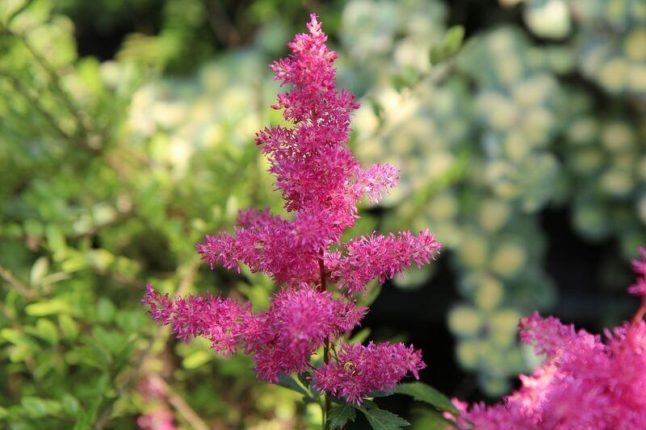
These showy flowers will grow wonderfully in your yard’s shady areas. Astilbe features fern-like foliage and produces clustering, feathery blooms reaching heights up to 2 feet.
Bloom time: Late spring to late summer.
Shade or sun: Light to moderate shade.
Color varieties: Pink, red, and white.
Common names: False goat’s beard and false spirea.
Hardiness zones: 3-9
Best time to plant: Spring.
18. Bleeding heart

These pretty flowers feature a fascinating, delicate shape that pleases the eye. Their vibrant colors dot the landscape as they hang from arching stems, and are perfect for sprucing up a dark shade garden.
Bloom time: Mid-to-late spring to early summer.
Shade or sun: Partial to full shade.
Color varieties: Pink, red, and white.
Common names: Asian bleeding-heart, heart flower, lady-in-a-bath, and lyre flower.
Hardiness zones: 3-9
Best time to plant: Spring.
19. Catmint

Catmint will bloom for months and is an excellent perennial to have in the yard for long-lasting cheer. You’ll be grateful for their soothing, cool colors on those hot summer days. These tough plants are low-maintenance, and they won’t expect you to break a sweat.
They won’t attract cats to your yard either. Although both members of the mint family, catnip and catmint are not the same plants. Catnip is what makes your cat go crazy. On the other hand, catmint won’t stimulate your cat, despite having ‘cat’ in its name.
Bloom time: Late spring to fall.
Shade or sun: Full sun to partial shade.
Color varieties: Blue-lavender, white, and pink.
Common names: Catmint.
Hardiness zones: 3-9
Best time to plant: Spring through early fall.
20. Hellebore

We love watching our perennials bloom as the days begin to warm, and life returns around us after a cold winter. But why not have a few winter-blooming hellebores sprinkling the landscape to spruce up your dreary grey yard?
And you won’t need to worry about deer and voles munching on the only blooms you have for the winter, as these animals do not like hellebore.
Bloom time: Late winter to early spring.
Shade or sun: Partial to full shade.
Color varieties: White, pinks, maroon, and deep purple.
Common names: Christmas rose, Lenten rose, and winter rose.
Hardiness zones: 4-9
Best time to plant: Fall.
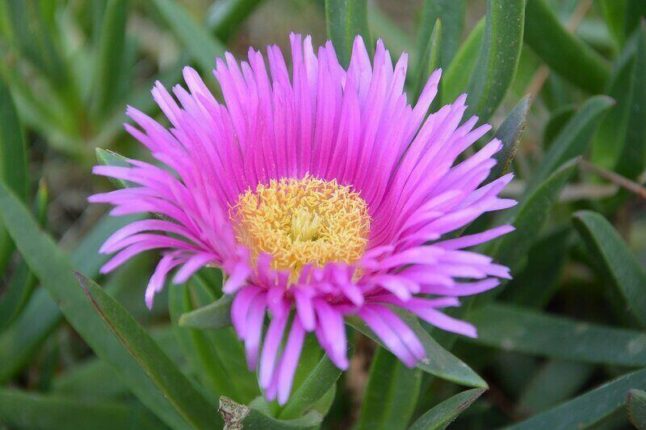
21. Delosperma
Delosperma (or ice plant) is a groovy addition to your garden because its flowers have striking, almost tie-dye-like gradient colors. Delosperma is named for the ice-coated appearance of its leaves.
Delosperma is a low-maintenance flowering succulent that prefers dry soils and sunlight. Delosperma also can be used as an attractive ground cover during its non-flowering season.
Note: Ice plants are invasive. These succulents can crowd all other plants in their general vicinity and spread incredibly quickly. The shallow root system does allow for easy removal, but Delosperma is hard to stop once it gets growing.
Bloom time: Mid-spring to early fall
Shade or sun: Full sun. Will tolerate light shade.
Color varieties: Yellow, red, pink, white, purple.
Common names: Ice plant
Hardiness zones: 5-9
Best time to plant: Mid-summer for cold climates, fall for warm climates.
Ask The Experts
- How do you recommend gardeners protect their perennials through the winter?
- What are your favorite perennials to grow in the garden?
- What are the best perennials for first-time gardeners?
- What should gardeners keep in mind when growing their perennial flower beds?


1. How do you recommend gardeners protect their perennials through the winter?
Hardy perennials should not need much in the way of protection. They go dormant and their crowns and roots remain protected. I will often blow my leaves into the garden and that can provide an addition layer of protection and organic matter.
Tender perennials can either be dug and composted, or simply left to decompose through the fall and winter. Perennials that are borderline hardy to a zone can have a larger layer of leaf litter or mulch piled around their crowns to help ensure their survival.
2. What are your favorite perennials to grow in the garden?
For sunny areas I love purple coneflowers (Echinacea), blazing star (Liatris), milkweed (Asclepias), garden phlox (Phlox), and candytuft (Iberis). They are all easy to care for plants that are not overly picky about soil as long as the drainage is decent.
For shady areas Hosta are always a popular choice, but coral bells (Heuchera), ferns (there are so many), hardy geranium, columbine (Aquilegia), and our native woodland phlox (Phlox stolonifera, and Phlox divaricata.)
3. What are the best perennials for first-time gardeners?
There are lots of easy-to-care-for perennials that require little management after they are established. Some commonly available ones are purple coneflower (Echinacea), tickseed (Coreopsis), bee balm (Monarda), stonecrop (Sedum – there are upright forms and ground cover forms), daylilies (Hemerocallis), false indigo (Baptisia), and Siberian iris.
Our native ornamental grasses are also easy to care for, switch grass (Panicum), big bluestem (Andropodon), and little bluestem (Schizachyrium) are all easy to care for, long-lived perennial grasses.
4. What should gardeners keep in mind when growing their perennial flower beds?
Perennials are not “no maintenance” plants, though through smart selection maintenance can be reduced. Allow the plants room to grow to maturity. Finally, they will require more care the first few weeks while their roots establish in the garden. Extra watering, and keeping the weeds away will ensure they adapt and thrive in their new home.
How to Choose the Right Perennials for Your Yard
Your landscape is all about the first impression. Which flowers show off your personality, which brings you the most delight as you step outside?
Some perennial plants may grow better in your plant hardiness zone than others, while some may grow better in your shady yard than perennials needing full sun.
Annuals produce magnificent flowers. But many gardeners are looking for ways to create more spare time for family or work in other areas of the garden. Perennials are an excellent way to save gardening time, as gardeners needn’t replant them every year, unlike their annuals.
When to Call a Professional Landscaper
Call a professional landscaper near you if you need assistance with landscape design, flower bed installation, or mulching for your flower beds.
If you can’t choose which plant to have in the landscape, a professional landscaper can create a customized design plan to help you visualize your dream yard.
Whether you’re working with a small space, a shady yard, or poor soil, a landscaping professional can help ease your worries and give your landscape the eye-popping curb appeal it deserves.
Main Photo Credit: zoosnow / Pexels